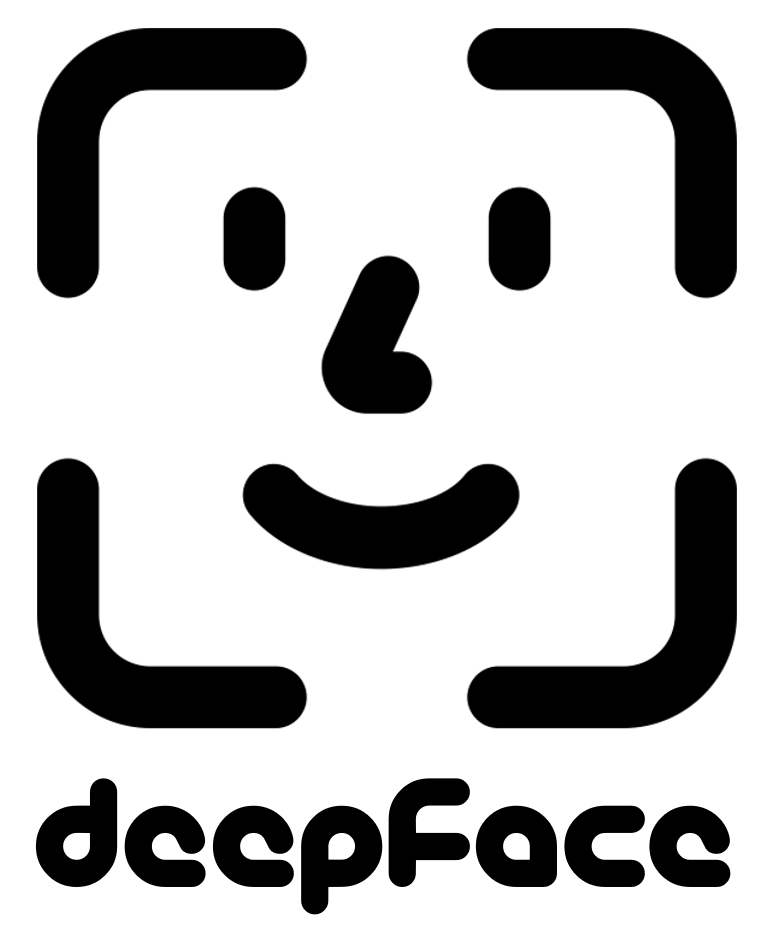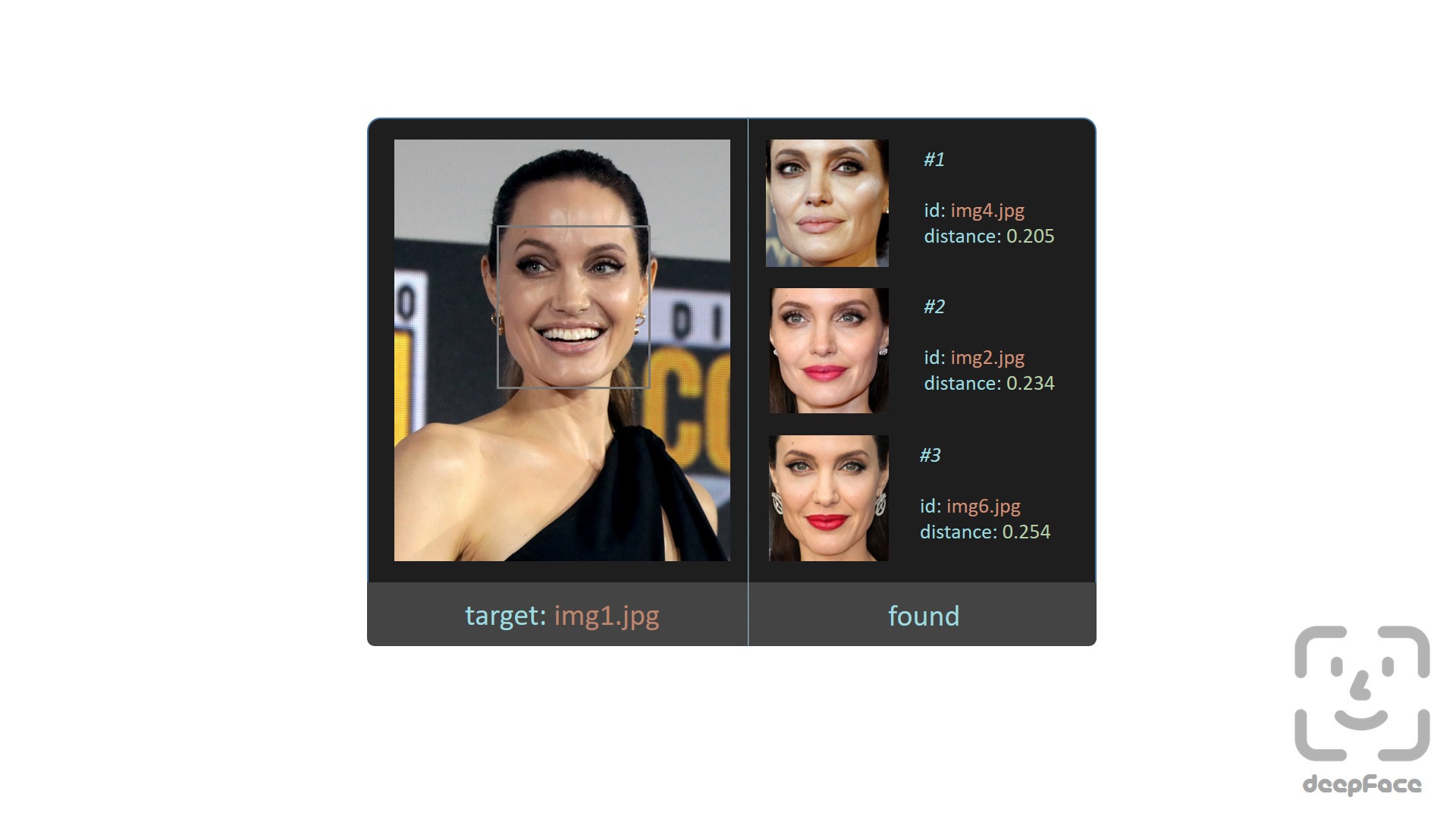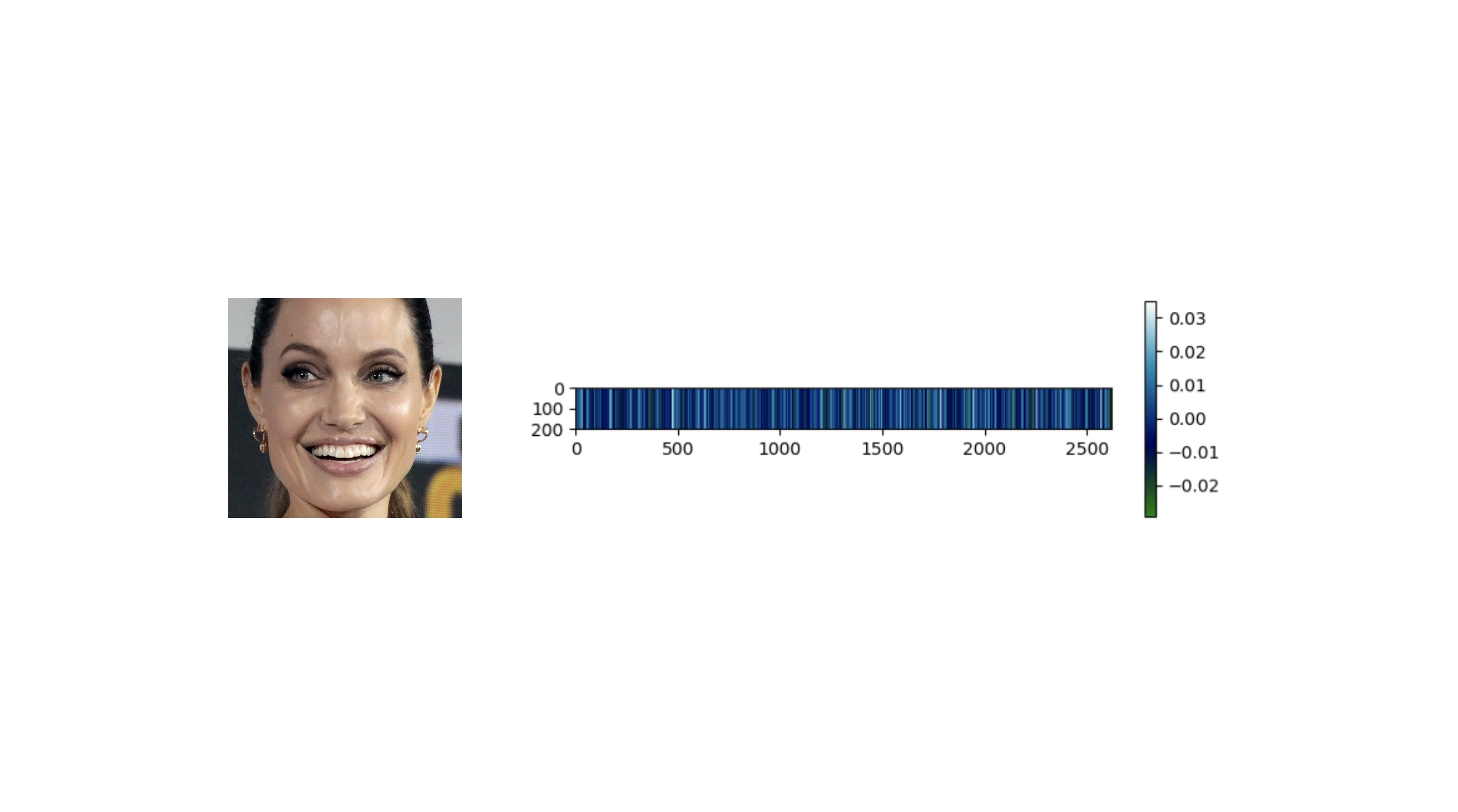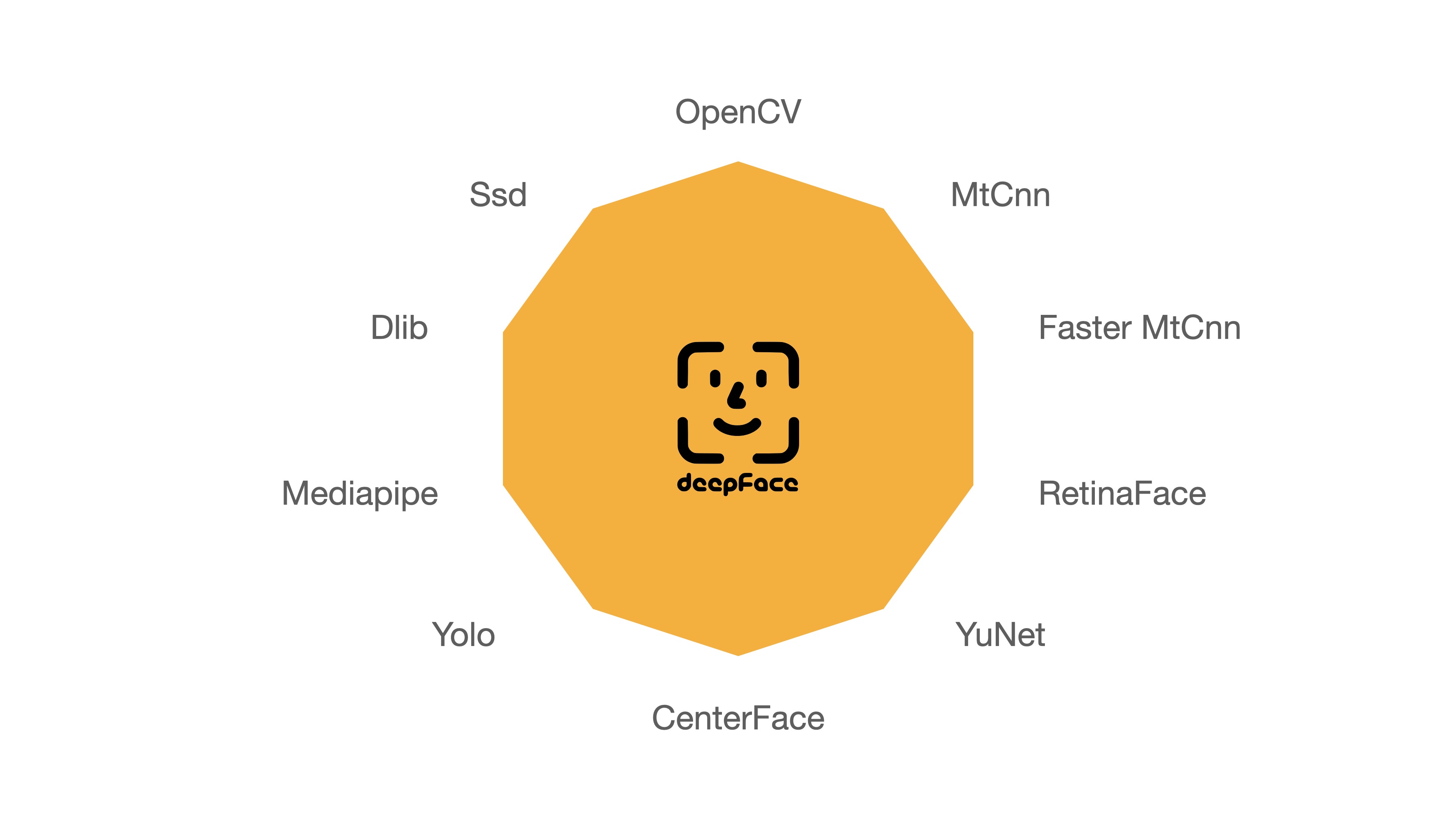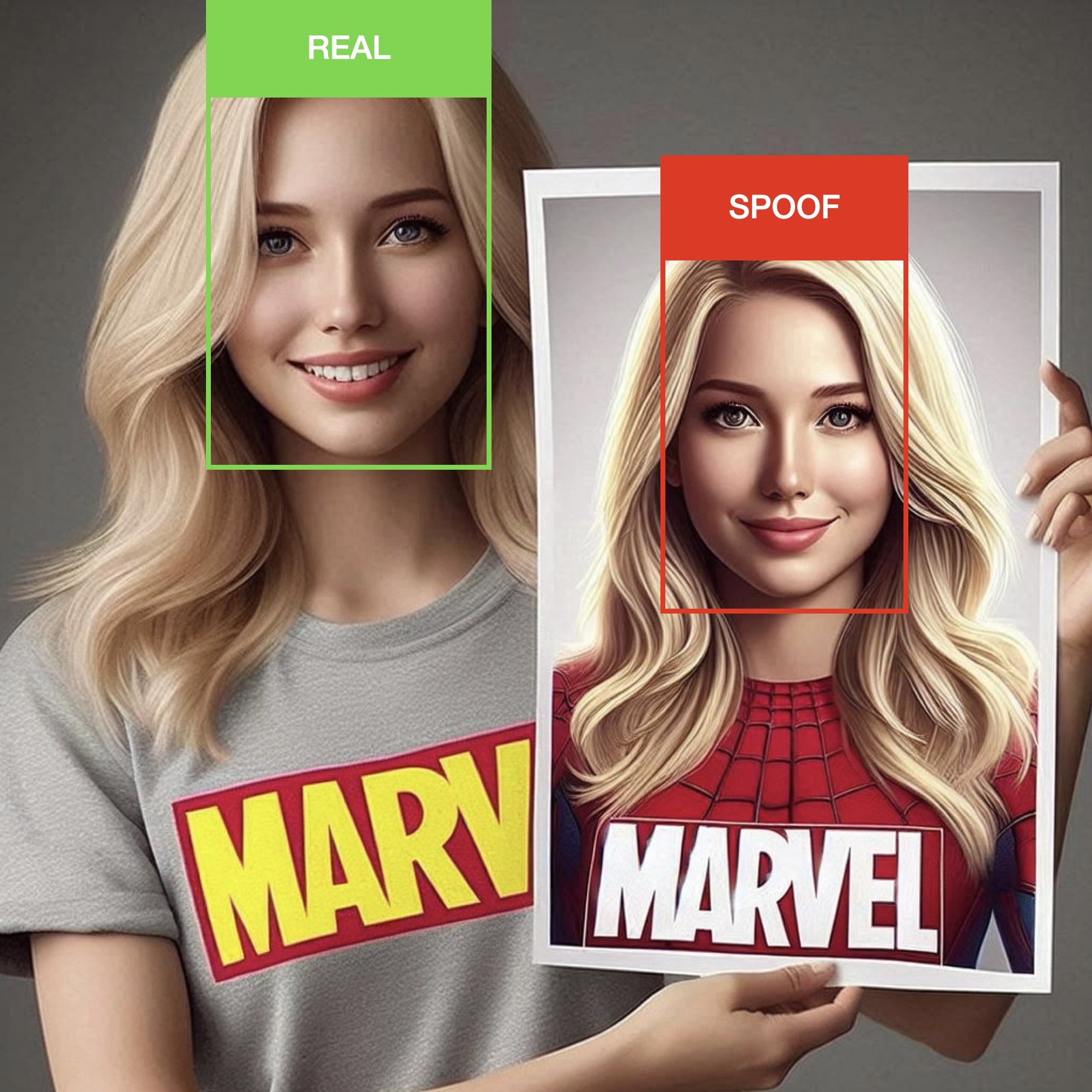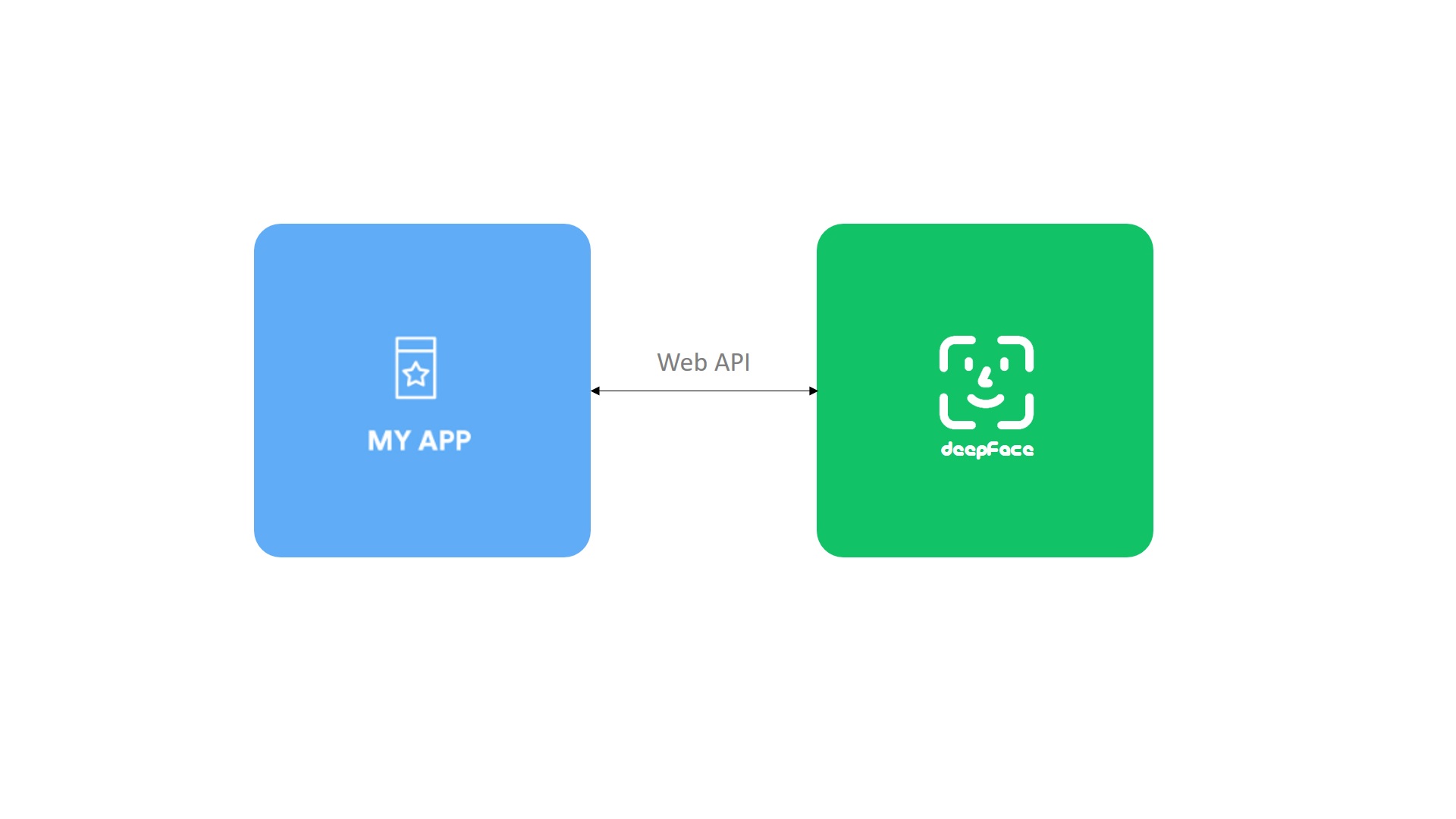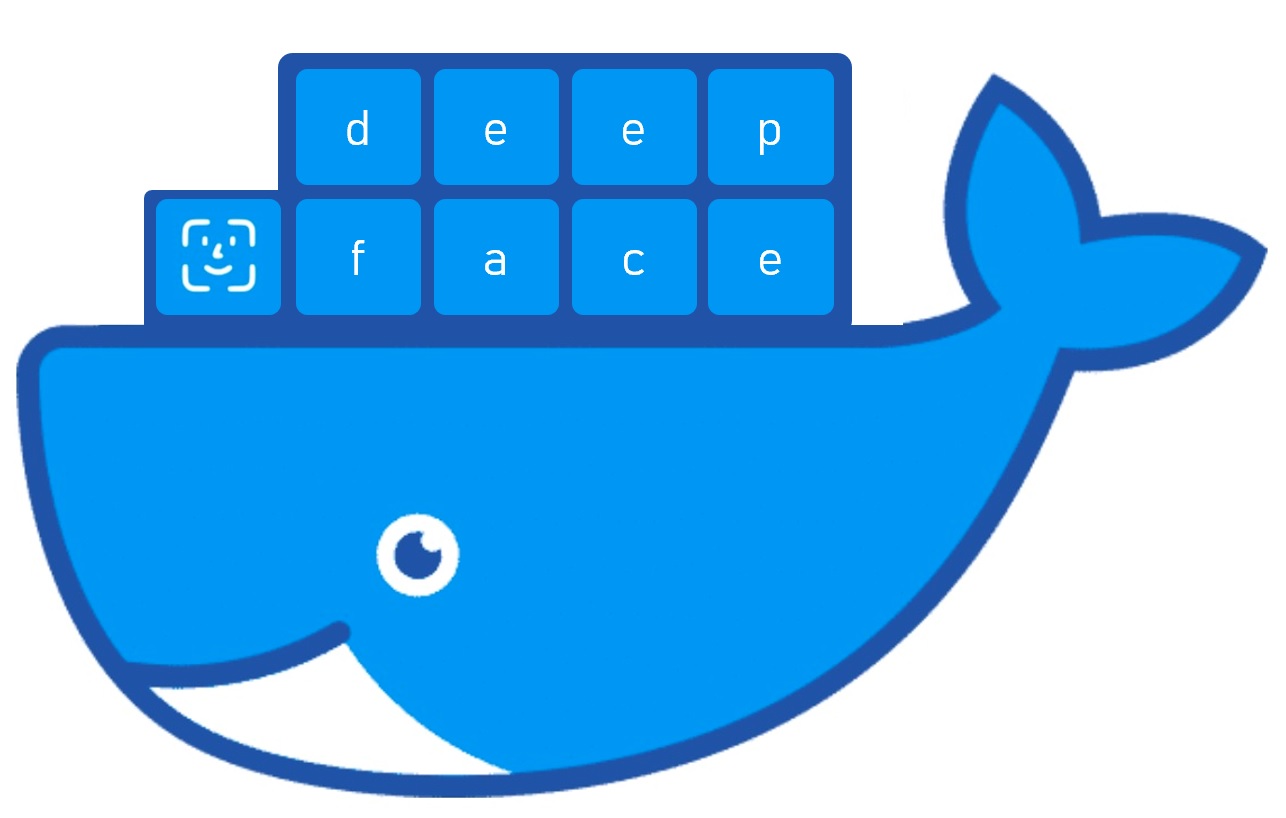A Lightweight Face Recognition and Facial Attribute Analysis Framework (Age, Gender, Emotion, Race) for Python
Project description
deepface
Deepface is a lightweight face recognition and facial attribute analysis (age, gender, emotion and race) framework for python. It is a hybrid face recognition framework wrapping state-of-the-art models: VGG-Face, FaceNet, OpenFace, DeepFace, DeepID, ArcFace, Dlib, SFace and GhostFaceNet.
Experiments show that human beings have 97.53% accuracy on facial recognition tasks whereas those models already reached and passed that accuracy level.
Installation 

The easiest way to install deepface is to download it from PyPI. It's going to install the library itself and its prerequisites as well.
$ pip install deepface
Secondly, DeepFace is also available at Conda. You can alternatively install the package via conda.
$ conda install -c conda-forge deepface
Thirdly, you can install deepface from its source code.
$ git clone https://github.com/serengil/deepface.git
$ cd deepface
$ pip install -e .
Then you will be able to import the library and use its functionalities.
from deepface import DeepFace
Facial Recognition - Demo
A modern face recognition pipeline consists of 5 common stages: detect, align, normalize, represent and verify. While Deepface handles all these common stages in the background, you don’t need to acquire in-depth knowledge about all the processes behind it. You can just call its verification, find or analysis function with a single line of code.
Face Verification - Demo
This function verifies face pairs as same person or different persons. It expects exact image paths as inputs. Passing numpy or base64 encoded images is also welcome. Then, it is going to return a dictionary and you should check just its verified key.
result = DeepFace.verify(
img1_path = "img1.jpg",
img2_path = "img2.jpg",
)
Face recognition - Demo
Face recognition requires applying face verification many times. Herein, deepface has an out-of-the-box find function to handle this action. It's going to look for the identity of input image in the database path and it will return list of pandas data frame as output. Meanwhile, facial embeddings of the facial database are stored in a pickle file to be searched faster in next time. Result is going to be the size of faces appearing in the source image. Besides, target images in the database can have many faces as well.
dfs = DeepFace.find(
img_path = "img1.jpg",
db_path = "C:/workspace/my_db",
)
Embeddings - Demo
Face recognition models basically represent facial images as multi-dimensional vectors. Sometimes, you need those embedding vectors directly. DeepFace comes with a dedicated representation function. Represent function returns a list of embeddings. Result is going to be the size of faces appearing in the image path.
embedding_objs = DeepFace.represent(
img_path = "img.jpg"
)
This function returns an array as embedding. The size of the embedding array would be different based on the model name. For instance, VGG-Face is the default model and it represents facial images as 4096 dimensional vectors.
for embedding_obj in embedding_objs:
embedding = embedding_obj["embedding"]
assert isinstance(embedding, list)
assert (
model_name == "VGG-Face"
and len(embedding) == 4096
)
Here, embedding is also plotted with 4096 slots horizontally. Each slot is corresponding to a dimension value in the embedding vector and dimension value is explained in the colorbar on the right. Similar to 2D barcodes, vertical dimension stores no information in the illustration.
Face recognition models - Demo
Deepface is a hybrid face recognition package. It currently wraps many state-of-the-art face recognition models: VGG-Face , FaceNet, OpenFace, DeepFace, DeepID, ArcFace, Dlib, SFace and GhostFaceNet. The default configuration uses VGG-Face model.
models = [
"VGG-Face",
"Facenet",
"Facenet512",
"OpenFace",
"DeepFace",
"DeepID",
"ArcFace",
"Dlib",
"SFace",
"GhostFaceNet",
]
#face verification
result = DeepFace.verify(
img1_path = "img1.jpg",
img2_path = "img2.jpg",
model_name = models[0],
)
#face recognition
dfs = DeepFace.find(
img_path = "img1.jpg",
db_path = "C:/workspace/my_db",
model_name = models[1],
)
#embeddings
embedding_objs = DeepFace.represent(
img_path = "img.jpg",
model_name = models[2],
)
FaceNet, VGG-Face, ArcFace and Dlib are overperforming ones based on experiments - see BENCHMARKS for more details. You can find the measured scores of various models in DeepFace and the reported scores from their original studies in the following table.
| Model | Measured Score | Declared Score |
|---|---|---|
| Facenet512 | 98.4% | 99.6% |
| Human-beings | 97.5% | 97.5% |
| Facenet | 97.4% | 99.2% |
| Dlib | 96.8% | 99.3 % |
| VGG-Face | 96.7% | 98.9% |
| ArcFace | 96.7% | 99.5% |
| GhostFaceNet | 93.3% | 99.7% |
| SFace | 93.0% | 99.5% |
| OpenFace | 78.7% | 92.9% |
| DeepFace | 69.0% | 97.3% |
| DeepID | 66.5% | 97.4% |
Conducting experiments with those models within DeepFace may reveal disparities compared to the original studies, owing to the adoption of distinct detection or normalization techniques. Furthermore, some models have been released solely with their backbones, lacking pre-trained weights. Thus, we are utilizing their re-implementations instead of the original pre-trained weights.
Similarity
Face recognition models are regular convolutional neural networks and they are responsible to represent faces as vectors. We expect that a face pair of same person should be more similar than a face pair of different persons.
Similarity could be calculated by different metrics such as Cosine Similarity, Euclidean Distance and L2 form. The default configuration uses cosine similarity.
metrics = ["cosine", "euclidean", "euclidean_l2"]
#face verification
result = DeepFace.verify(
img1_path = "img1.jpg",
img2_path = "img2.jpg",
distance_metric = metrics[1],
)
#face recognition
dfs = DeepFace.find(
img_path = "img1.jpg",
db_path = "C:/workspace/my_db",
distance_metric = metrics[2],
)
Euclidean L2 form seems to be more stable than cosine and regular Euclidean distance based on experiments.
Facial Attribute Analysis - Demo
Deepface also comes with a strong facial attribute analysis module including age, gender, facial expression (including angry, fear, neutral, sad, disgust, happy and surprise) and race (including asian, white, middle eastern, indian, latino and black) predictions. Result is going to be the size of faces appearing in the source image.
objs = DeepFace.analyze(
img_path = "img4.jpg",
actions = ['age', 'gender', 'race', 'emotion'],
)
Age model got ± 4.65 MAE; gender model got 97.44% accuracy, 96.29% precision and 95.05% recall as mentioned in its tutorial.
Face Detectors - Demo
Face detection and alignment are important early stages of a modern face recognition pipeline. Experiments show that detection increases the face recognition accuracy up to 42%, while alignment increases it up to 6%. OpenCV, Ssd, Dlib, MtCnn, Faster MtCnn, RetinaFace, MediaPipe, Yolo, YuNet and CenterFace detectors are wrapped in deepface.
All deepface functions accept an optional detector backend input argument. You can switch among those detectors with this argument. OpenCV is the default detector.
backends = [
'opencv',
'ssd',
'dlib',
'mtcnn',
'fastmtcnn',
'retinaface',
'mediapipe',
'yolov8',
'yunet',
'centerface',
]
#face verification
obj = DeepFace.verify(
img1_path = "img1.jpg",
img2_path = "img2.jpg",
detector_backend = backends[0],
)
#face recognition
dfs = DeepFace.find(
img_path = "img.jpg",
db_path = "my_db",
detector_backend = backends[1],
)
#embeddings
embedding_objs = DeepFace.represent(
img_path = "img.jpg",
detector_backend = backends[2],
)
#facial analysis
demographies = DeepFace.analyze(
img_path = "img4.jpg",
detector_backend = backends[3],
)
#face detection and alignment
face_objs = DeepFace.extract_faces(
img_path = "img.jpg",
detector_backend = backends[4],
)
Face recognition models are actually CNN models and they expect standard sized inputs. So, resizing is required before representation. To avoid deformation, deepface adds black padding pixels according to the target size argument after detection and alignment.
RetinaFace and MtCnn seem to overperform in detection and alignment stages but they are much slower. If the speed of your pipeline is more important, then you should use opencv or ssd. On the other hand, if you consider the accuracy, then you should use retinaface or mtcnn.
The performance of RetinaFace is very satisfactory even in the crowd as seen in the following illustration. Besides, it comes with an incredible facial landmark detection performance. Highlighted red points show some facial landmarks such as eyes, nose and mouth. That's why, alignment score of RetinaFace is high as well.

The Yellow Angels - Fenerbahce Women's Volleyball Team
You can find out more about RetinaFace on this repo.
Real Time Analysis - Demo
You can run deepface for real time videos as well. Stream function will access your webcam and apply both face recognition and facial attribute analysis. The function starts to analyze a frame if it can focus a face sequentially 5 frames. Then, it shows results 5 seconds.
DeepFace.stream(db_path = "C:/User/Sefik/Desktop/database")
Even though face recognition is based on one-shot learning, you can use multiple face pictures of a person as well. You should rearrange your directory structure as illustrated below.
user
├── database
│ ├── Alice
│ │ ├── Alice1.jpg
│ │ ├── Alice2.jpg
│ ├── Bob
│ │ ├── Bob.jpg
Face Anti Spoofing - Demo
DeepFace also includes an anti-spoofing analysis module to understand given image is real or fake. To activate this feature, set the anti_spoofing argument to True in any DeepFace tasks.
# anti spoofing test in face detection
face_objs = DeepFace.extract_faces(
img_path="dataset/img1.jpg",
anti_spoofing = True
)
assert all(face_obj["is_real"] is True for face_obj in face_objs)
# anti spoofing test in real time analysis
DeepFace.stream(
db_path = "C:/User/Sefik/Desktop/database",
anti_spoofing = True
)
API - Demo
DeepFace serves an API as well - see api folder for more details. You can clone deepface source code and run the api with the following command. It will use gunicorn server to get a rest service up. In this way, you can call deepface from an external system such as mobile app or web.
cd scripts
./service.sh
Face recognition, facial attribute analysis and vector representation functions are covered in the API. You are expected to call these functions as http post methods. Default service endpoints will be http://localhost:5005/verify for face recognition, http://localhost:5005/analyze for facial attribute analysis, and http://localhost:5005/represent for vector representation. You can pass input images as exact image paths on your environment, base64 encoded strings or images on web. Here, you can find a postman project to find out how these methods should be called.
Dockerized Service - Demo
The following command set will serve deepface on localhost:5005 via docker. Then, you will be able to consume deepface services such as verify, analyze and represent. Also, if you want to build the image by your own instead of pre-built image from docker hub, Dockerfile is available in the root folder of the project.
# docker build -t serengil/deepface . # build docker image from Dockerfile
docker pull serengil/deepface # use pre-built docker image from docker hub
docker run -p 5005:5000 serengil/deepface
Command Line Interface - Demo
DeepFace comes with a command line interface as well. You are able to access its functions in command line as shown below. The command deepface expects the function name as 1st argument and function arguments thereafter.
#face verification
$ deepface verify -img1_path tests/dataset/img1.jpg -img2_path tests/dataset/img2.jpg
#facial analysis
$ deepface analyze -img_path tests/dataset/img1.jpg
You can also run these commands if you are running deepface with docker. Please follow the instructions in the shell script.
Contribution
Pull requests are more than welcome! If you are planning to contribute a large patch, please create an issue first to get any upfront questions or design decisions out of the way first.
Before creating a PR, you should run the unit tests and linting locally by running make test && make lint command. Once a PR sent, GitHub test workflow will be run automatically and unit test and linting jobs will be available in GitHub actions before approval.
Support
There are many ways to support a project - starring⭐️ the GitHub repo is just one 🙏
You can also support this work on Patreon or GitHub Sponsors.

Citation
Please cite deepface in your publications if it helps your research - see CITATIONS for more details. Here are its BibTex entries:
If you use deepface in your research for facial recogntion or face detection purposes, please cite this publication:
@article{serengil2024lightface,
title = {A Benchmark of Facial Recognition Pipelines and Co-Usability Performances of Modules},
author = {Serengil, Sefik and Ozpinar, Alper},
journal = {Bilisim Teknolojileri Dergisi},
volume = {17},
number = {2},
pages = {95-107},
year = {2024},
doi = {10.17671/gazibtd.1399077},
url = {https://dergipark.org.tr/en/pub/gazibtd/issue/84331/1399077},
publisher = {Gazi University}
}
If you use deepface in your research for facial attribute analysis purposes such as age, gender, emotion or ethnicity prediction, please cite this publication.
@inproceedings{serengil2021lightface,
title = {HyperExtended LightFace: A Facial Attribute Analysis Framework},
author = {Serengil, Sefik Ilkin and Ozpinar, Alper},
booktitle = {2021 International Conference on Engineering and Emerging Technologies (ICEET)},
pages = {1-4},
year = {2021},
doi = {10.1109/ICEET53442.2021.9659697},
url = {https://ieeexplore.ieee.org/document/9659697},
organization = {IEEE}
}
Also, if you use deepface in your GitHub projects, please add deepface in the requirements.txt.
Licence
DeepFace is licensed under the MIT License - see LICENSE for more details.
DeepFace wraps some external face recognition models: VGG-Face, Facenet (both 128d and 512d), OpenFace, DeepFace, DeepID, ArcFace, Dlib, SFace and GhostFaceNet. Besides, age, gender and race / ethnicity models were trained on the backbone of VGG-Face with transfer learning. Similarly, DeepFace wraps many face detectors: OpenCv, Ssd, Dlib, MtCnn, Fast MtCnn, RetinaFace, MediaPipe, YuNet, Yolo and CenterFace. Finally, DeepFace is optionally using face anti spoofing to determine the given images are real or fake. License types will be inherited when you intend to utilize those models. Please check the license types of those models for production purposes.
DeepFace logo is created by Adrien Coquet and it is licensed under Creative Commons: By Attribution 3.0 License.
Project details
Release history Release notifications | RSS feed
Download files
Download the file for your platform. If you're not sure which to choose, learn more about installing packages.
Source Distribution
Built Distribution
File details
Details for the file deepface-0.0.92.tar.gz.
File metadata
- Download URL: deepface-0.0.92.tar.gz
- Upload date:
- Size: 77.9 kB
- Tags: Source
- Uploaded using Trusted Publishing? No
- Uploaded via: twine/3.8.0 pkginfo/1.8.2 readme-renderer/32.0 requests/2.31.0 requests-toolbelt/0.10.1 urllib3/1.26.15 tqdm/4.50.2 importlib-metadata/6.8.0 keyring/23.5.0 rfc3986/2.0.0 colorama/0.4.4 CPython/3.8.5
File hashes
| Algorithm | Hash digest | |
|---|---|---|
| SHA256 | cad2432e8499fd1b45208769665c74aad199c8f0a9713a2542230d8b873100c4 |
|
| MD5 | 2626fe9b73ead1233649ece68aca58a4 |
|
| BLAKE2b-256 | efa7685eef552de9d911b99e95beda6e65157cf6a5d762078c0da6902e7fee28 |
File details
Details for the file deepface-0.0.92-py3-none-any.whl.
File metadata
- Download URL: deepface-0.0.92-py3-none-any.whl
- Upload date:
- Size: 105.5 kB
- Tags: Python 3
- Uploaded using Trusted Publishing? No
- Uploaded via: twine/3.8.0 pkginfo/1.8.2 readme-renderer/32.0 requests/2.31.0 requests-toolbelt/0.10.1 urllib3/1.26.15 tqdm/4.50.2 importlib-metadata/6.8.0 keyring/23.5.0 rfc3986/2.0.0 colorama/0.4.4 CPython/3.8.5
File hashes
| Algorithm | Hash digest | |
|---|---|---|
| SHA256 | c58e8c7ac91f7475c86e0dcb758492f6dda3883e080f036444072b9c66a65e1c |
|
| MD5 | f250efb7529023d8737319707f38cae7 |
|
| BLAKE2b-256 | 4c053e881f6d3c20d45561ab3c4d8c5c38c500eff4743ad155075c2bcb519a84 |














